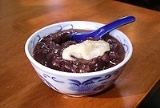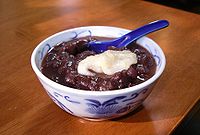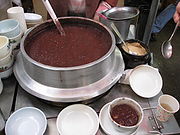
Oshiruko
Encyclopedia
Red bean soup refers to a number of traditional Asian soup
s, all made with azuki bean
s.
, red bean soup (紅豆沙, pinyin: hǒng dòu shā) is a popular dish. The soup is commonly thinner than the Japanese oshiruko version. It is categorized as a tang shui糖水, (pinyin: táng shǔi) (literally translated as sugar water), or sweet soup. It is often served cold during the summer, and hot in the winter. Leftover red bean soup can also be frozen to make ice pop
s and is a popular dessert.
It is one of the main desserts offered after Cantonese cuisine
meals in restaurants at night. When served, it is plain most of the time. The fancier restaurants may offer red bean soup with sago
(西米, pinyin: xī mi). The two types of sugar used interchangeably are rock sugar
and sliced sugar (片糖).
 , or with the honorific "o" (お), is a traditional Japanese
, or with the honorific "o" (お), is a traditional Japanese
dessert
. It is a sweet porridge of azuki beans boiled and crushed, served in a bowl with mochi. There are different styles of shiruko, such as shiruko with chestnut
s, or with glutinous rice
flour dumpling
s instead of mochi.
There are two types of shiruko based on difference of cooking way of azuki beans. Azuki beans could be turned into paste, crushed without keeping its original shape, or paste and roughly crushed beans are mixed. There is a similar dish, , which is made from condensed paste with heat and is less watery than shiruko, like making jam or marmalade. In Western Japan, Zenzai refers to a type of shiruko made from mixture of paste and crushed beans. In Okinawa Prefecture, the term "zenzai" commonly refers to this bean soup served over shaved ice with "mochi". Other toppings, such as sweetened condensed milk, are occasionally added for flavor.
It is loved by many Japanese, especially during the winter. The half-melted sticky mochi and the sweet, warm azuki bean porridge is thought by many to be an absolute delight. Shiruko is frequently served with a side dish of something sour or salty, such as umeboshi
or shiokombu. This is because shiruko is so sweet that the taste cloys after a while, so the customer can refresh their palate with something sour or salty, such as shiokombu or umeboshi, or both.
In some regions including Kagawa Prefecture
, shiruko is also used for zōni
, the special soup for New Year celebration.
 In Korean cuisine, red bean soup is called patjuk (팥죽), and is commonly eaten during the winter season. On Dongjinal, a Korean traditional holiday which falls on December 22, Korean people eat Donji patjuk, which contains saealsim (새알심) meaning bird egg, a ball made from glutinous rice flour, named such due to its resemblance to small bird's eggs, possibly quail eggs.
In Korean cuisine, red bean soup is called patjuk (팥죽), and is commonly eaten during the winter season. On Dongjinal, a Korean traditional holiday which falls on December 22, Korean people eat Donji patjuk, which contains saealsim (새알심) meaning bird egg, a ball made from glutinous rice flour, named such due to its resemblance to small bird's eggs, possibly quail eggs.
In old Korean tradition, patjuk is believed to have a mysterious power to drive evil spirits away. According to Korean traditional folk beliefs, the color "red" is a symbolic color of positive energy which can defeat negative energy. Cooking and eating patjuk is a ritual to prevent bad luck, epidemic disease, and comes from evil spirits. Before eating the dish, Korean people used to serve it their own house shrine, they scattered it all around the house like in the kitchen, storage house, gate, yard and so on. These customs have been handed down through Chinese mythological stories. According to Hyungchosesigi, there was a man named Gong Gong. He had a bad son, and after he died he became a god of epidemic disease. Because of his cruel temper, a lot of people were killed by epidemics. Trying to find a solution to prevent infectious diseases, they recalled the fact that the son of Gong Gong hated "red bean soup" when he was alive. Thus, people made red bean soup and scattered it all around the house. And then the epidemics disappeared. Since then, patjuk has been the food that all spirits hate.
Eating patjuk is a ritual to wish for abundant harvests. Ancient Korea was an agrarian society, and a rich harvest has always been a pivotal issue for them. Koreans eat Patjuk (red bean soup) on Donggi(winter solstice), when the days start becoming longer than nights. When they make Patjuk (red bean soup) they add small dumplings which were made of rice as the same number as their age. By fully relaxing and eating nourishing health food, they wanted to have a preparation period before starting farming in the spring.
Patjuk embodies a custom of conserving food. Koreans usually eat rice and side dishes. However, in the wintertime when Korean families had shortage of grains, patjuk became a complete meal itself. It could be made of simple ingredients. For example, red beans, water, small grains of rice and also it requires no need extra side dishes. Thus, when people prepare some events in winter, patjuk is an economical food for conserving grain.
đậu đỏ.photo , it contains added coconut milk
.
s.
Asian soup
Asian soups are soups traditionally prepared and consumed in the cultures of East Asia. Such soups are usually based solely on broths and lacking in dairy products such as milk or cream. Thickening for the soups usually consists of refined starches from corn or sweet potatoes.Asian soups are...
s, all made with azuki bean
Azuki bean
The is an annual vine, Vigna angularis, widely grown throughout East Asia and the Himalayas for its small bean. The cultivars most familiar in north-east Asia have a uniform red color, but white, black, gray and variously mottled varieties are also known. Scientists presume Vigna angularis var...
s.
China
In ChinaChina
Chinese civilization may refer to:* China for more general discussion of the country.* Chinese culture* Greater China, the transnational community of ethnic Chinese.* History of China* Sinosphere, the area historically affected by Chinese culture...
, red bean soup (紅豆沙, pinyin: hǒng dòu shā) is a popular dish. The soup is commonly thinner than the Japanese oshiruko version. It is categorized as a tang shui糖水, (pinyin: táng shǔi) (literally translated as sugar water), or sweet soup. It is often served cold during the summer, and hot in the winter. Leftover red bean soup can also be frozen to make ice pop
Ice pop
An ice pop, also referred to in the United States as a popsicle, and in the United Kingdom as an ice lolly, lolly ice or ice lollipop, is a frozen, water-based dessert. It is made by freezing flavored liquid around a stick. Often, the juice is colored artificially...
s and is a popular dessert.
It is one of the main desserts offered after Cantonese cuisine
Cantonese cuisine
Cantonese cuisine comes from Guangdong Province in southern China and is one of 8 superdivisions of Chinese cuisine. Its prominence outside China is due to the great numbers of early emigrants from Guangdong. Cantonese chefs are highly sought after throughout the country...
meals in restaurants at night. When served, it is plain most of the time. The fancier restaurants may offer red bean soup with sago
Sago
Sago is a starch extracted in the spongy center or pith, of various tropical palm stems, Metroxylon sagu. It is a major staple food for the lowland peoples of New Guinea and the Moluccas, where it is called saksak and sagu. A type of flour, called sago flour, is made from sago. The largest supply...
(西米, pinyin: xī mi). The two types of sugar used interchangeably are rock sugar
Rock candy
Rock candy is a type of confectionery mineral composed of relatively large sugar crystals. This candy is formed by allowing a supersaturated solution of sugar and water to crystallize onto a surface suitable for crystal nucleation, such as a string or stick...
and sliced sugar (片糖).
Japan

Japanese cuisine
Japanese cuisine has developed over the centuries as a result of many political and social changes throughout Japan. The cuisine eventually changed with the advent of the Medieval age which ushered in a shedding of elitism with the age of shogun rule...
dessert
Dessert
In cultures around the world, dessert is a course that typically comes at the end of a meal, usually consisting of sweet food. The word comes from the French language as dessert and this from Old French desservir, "to clear the table" and "to serve." Common Western desserts include cakes, biscuits,...
. It is a sweet porridge of azuki beans boiled and crushed, served in a bowl with mochi. There are different styles of shiruko, such as shiruko with chestnut
Chestnut
Chestnut , some species called chinkapin or chinquapin, is a genus of eight or nine species of deciduous trees and shrubs in the beech family Fagaceae, native to temperate regions of the Northern Hemisphere. The name also refers to the edible nuts they produce.-Species:The chestnut belongs to the...
s, or with glutinous rice
Glutinous rice
Glutinous rice is a type of short-grained Asian rice that is especially sticky when cooked. It is called glutinous Glutinous rice (Oryza sativa var. glutinosa or Oryza glutinosa; also called sticky rice, sweet rice, waxy rice, botan rice, biroin chal, mochi rice, and pearl rice, and pulut) is a...
flour dumpling
Dumpling
Dumplings are cooked balls of dough. They are based on flour, potatoes or bread, and may include meat, fish, vegetables, or sweets. They may be cooked by boiling, steaming, simmering, frying, or baking. They may have a filling, or there may be other ingredients mixed into the dough. Dumplings may...
s instead of mochi.
There are two types of shiruko based on difference of cooking way of azuki beans. Azuki beans could be turned into paste, crushed without keeping its original shape, or paste and roughly crushed beans are mixed. There is a similar dish, , which is made from condensed paste with heat and is less watery than shiruko, like making jam or marmalade. In Western Japan, Zenzai refers to a type of shiruko made from mixture of paste and crushed beans. In Okinawa Prefecture, the term "zenzai" commonly refers to this bean soup served over shaved ice with "mochi". Other toppings, such as sweetened condensed milk, are occasionally added for flavor.
It is loved by many Japanese, especially during the winter. The half-melted sticky mochi and the sweet, warm azuki bean porridge is thought by many to be an absolute delight. Shiruko is frequently served with a side dish of something sour or salty, such as umeboshi
Umeboshi
Umeboshi are pickled ume fruits common in Japan. Ume is a species of fruit-bearing tree in the genus Prunus, which is often called a plum but is actually more closely related to the apricot. Umeboshi are a popular kind of tsukemono and are extremely sour and salty...
or shiokombu. This is because shiruko is so sweet that the taste cloys after a while, so the customer can refresh their palate with something sour or salty, such as shiokombu or umeboshi, or both.
In some regions including Kagawa Prefecture
Kagawa Prefecture
is a prefecture of Japan located on Shikoku island. The capital is Takamatsu.- History :Kagawa was formerly known as Sanuki Province.For a brief period between August 1876 and December 1888, Kagawa was made a part of Ehime Prefecture.-Battle of Yashima:...
, shiruko is also used for zōni
Zoni soup
, often with the honorific "o-" as o-zōni, is a Japanese soup containing mochi rice cakes. The dish is strongly associated with the Japanese New Year and its tradition of osechi ceremonial foods....
, the special soup for New Year celebration.
Korea

In old Korean tradition, patjuk is believed to have a mysterious power to drive evil spirits away. According to Korean traditional folk beliefs, the color "red" is a symbolic color of positive energy which can defeat negative energy. Cooking and eating patjuk is a ritual to prevent bad luck, epidemic disease, and comes from evil spirits. Before eating the dish, Korean people used to serve it their own house shrine, they scattered it all around the house like in the kitchen, storage house, gate, yard and so on. These customs have been handed down through Chinese mythological stories. According to Hyungchosesigi, there was a man named Gong Gong. He had a bad son, and after he died he became a god of epidemic disease. Because of his cruel temper, a lot of people were killed by epidemics. Trying to find a solution to prevent infectious diseases, they recalled the fact that the son of Gong Gong hated "red bean soup" when he was alive. Thus, people made red bean soup and scattered it all around the house. And then the epidemics disappeared. Since then, patjuk has been the food that all spirits hate.
Eating patjuk is a ritual to wish for abundant harvests. Ancient Korea was an agrarian society, and a rich harvest has always been a pivotal issue for them. Koreans eat Patjuk (red bean soup) on Donggi(winter solstice), when the days start becoming longer than nights. When they make Patjuk (red bean soup) they add small dumplings which were made of rice as the same number as their age. By fully relaxing and eating nourishing health food, they wanted to have a preparation period before starting farming in the spring.
Patjuk embodies a custom of conserving food. Koreans usually eat rice and side dishes. However, in the wintertime when Korean families had shortage of grains, patjuk became a complete meal itself. It could be made of simple ingredients. For example, red beans, water, small grains of rice and also it requires no need extra side dishes. Thus, when people prepare some events in winter, patjuk is an economical food for conserving grain.
Vietnam
Vietnamese cuisine also has a similar dish, called chèChè
Chè is a Vietnamese term that refers to any traditional Vietnamese sweet dessert soup or pudding.As such, it may, with the addition of qualifying adjectives, refer to a wide variety of distinct soups or puddings, which may be served either hot or cold...
đậu đỏ.photo , it contains added coconut milk
Coconut milk
Coconut milk is the water that comes from the grated meat of a coconut. The colour and rich taste of the milk can be attributed to the high oil content. In many parts of the world, the term coconut milk is also used to refer to coconut water, the naturally occurring liquid found inside the hollow...
.
Australia
In major cities around Australia, it is sometimes served as complimentary dessert along with fruit, pudding and sometimes cake and biscuits at Cantonese restaurantCantonese restaurant
A Cantonese restaurant is a type of Chinese restaurant that originated from Southern China. This style of restaurant soon flourished in Hong Kong.-History:Some of the earliest restaurants in Colonial Hong Kong were influenced by Cantonese people...
s.

